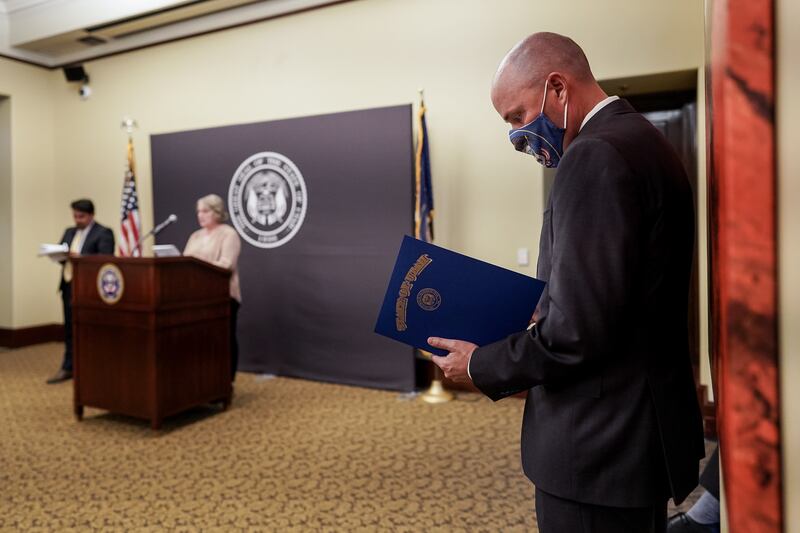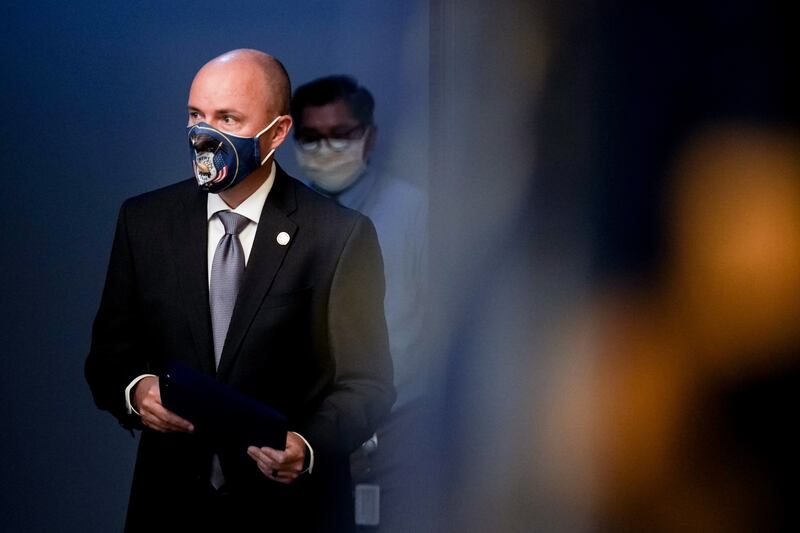SALT LAKE CITY — The Utah Department of Health on Thursday reported 50,557 total known COVID-19 infections in Utah to date, an increase of 383 cases since Wednesday.
The daily case numbers have stayed below Gov. Gary Herbert’s target of 400 per day for more than two weeks, though health officials are wary of the effect reopening schools could have on the number of cases throughout the state.
“We are certainly pleased that we’ve gone down and would like to see it continue to decline,” Salt Lake County Health Department Director Gary Edwards said on Thursday. “There’s a lot of uncertainty around what school opening will bring.”
Cases, particularly in Salt Lake County, are still higher than expected among minority populations, though officials are seeing progress there, too.
The health department reports that the majority of outbreaks — where two or more cases exist at one location — involve long-term health care facilities. Three hundred eighty of the state’s licensed long-term health care facilities currently are experiencing COVID-19 outbreaks, where 1,166 residents have tested positive and 184 have died from the disease. Five of those facilities have five or more active cases, according to the health department.
In addition, 1,024 caregivers at Utah’s long-term health care facilities have also tested positive with COVID-19.
Other outbreaks in the state have occurred at workplaces, hospitals and clinics, group living and detention facilities, schools and child care facilities, according to the health department.
State data shows that since mid-March, there have been 91 people who have tested positive at 17 Utah schools. However, since Aug. 13, there have been outbreaks at six different public schools, with 46 known COVID-19 infections.
Encouraging health among Utah’s minorities
Utah Lt. Gov. Spencer Cox held a Spanish news conference at the Capitol on Thursday, providing resources for Hispanic parents and communities to “safely navigate going back to school,” he said.
“The Hispanic community, unfortunately, has been more affected than others in our state,” Cox said.

Demographic data shows that 36% of Utah’s COVID-19 cases are among Hispanic and Latino populations, though Hispanics and Latinos make up just over 14% of the entire state’s population. Cases among Pacific Islander populations are also disproportionately high.
Positive cases in Salt Lake City reportedly peaked 14 days after Mayor Jenny Wilson instituted a mask mandate, requiring face coverings in public. She said she would’ve never mandated masks if the data didn’t point to it being the best option.
“I did have fear that we would see some pretty dire consequences in the community,” she said. “We now have the results and the results are that it was the right call.”
Wilson said she knew the local economy could not recover if people continued to be unhealthy.
“Of course I care about health, but you can’t get to a strong economy if you can’t get COVID-19 under control,” she said, adding that being “aggressive on the health side was for the benefit of the health of the economy.”
Observational studies done in the five most populated counties of the state indicate that in communities where masks are actively promoted, more people wear them, Edwards said.
“The older individuals are, the more likely they are to be compliant with mask requirements,” he said. Compliance rates, he said, go along with known health risks of COVID-19 — as, “the older you are, the more likely you are to have more serious illness.”
Tests are still available in Utah
Another 5,432 people were tested in Utah, bringing the total number of people tested in the state to 642,761. The seven-day average percent positivity is 8.7%, with an average of 366 new cases per day, the health department reports.
Earlier this week, the U.S. Centers for Disease Control and Prevention changed its guidance on COVID-19 testing, saying people without symptoms, even if they had come in contact with a known positive case, do not need to be tested. Testing, however, has been the only way to know how expansive the disease is within communities, making the new guidance bewildering.
The CDC further clarified its updated guidelines on Thursday, saying anyone who comes in contact with a confirmed or probable case can be tested, even if they don’t show symptoms.
“Everyone who needs a COVID-19 test, can get a test,” CDC Director Robert Redfield said. “Everyone who wants a test does not necessarily need a test; the key is to engage the needed public health community in the decision with the appropriate follow-up action.”
While tests may be in short supply in some states, that has not been the case in Utah, where capacity still exists to test anyone who wants to be tested.
Two more people have died with COVID-19 in Utah, both Salt Lake County men — one between the ages of 64 and 85, who was hospitalized at the time of his death; and another between the ages of 45 and 64, whose status at the time of his death is unknown.
The total number of people who have died because of COVID-19 in Utah is 403.
The health department reports 120 people are currently hospitalized throughout Utah.
For more information, visit coronavirus.utah.gov.
The latest breakdown of Utah cases, hospitalizations and deaths by health district:
- Salt Lake County, 23,355; 1,519 hospitalized; 229 deaths.
- Utah County, 10,539; 492 hospitalized; 46 deaths.
- Davis County, 3,741; 210 hospitalized; 23 deaths.
- Southwest Utah, 3,522; 206 hospitalized; 27 deaths.
- Weber-Morgan, 3,243; 208 hospitalized; 29 deaths.
- Bear River (Box Elder, Cache, Rich), 2,526; 129 hospitalized; 9 deaths.
- Summit County, 832; 53 hospitalized; 1 death.
- Tooele County, 673; 33 hospitalized; 0 deaths.
- San Juan County, 663; 88 hospitalized; 28 deaths.
- Wasatch County, 625; 25 hospitalized; 6 deaths.
- Central Utah, 498; 29 hospitalized; 3 deaths.
- TriCounty (Uinta Basin), 203; 17 hospitalized; 1 death.
- Southeast Utah, 137; 6 hospitalized; 1 death.


